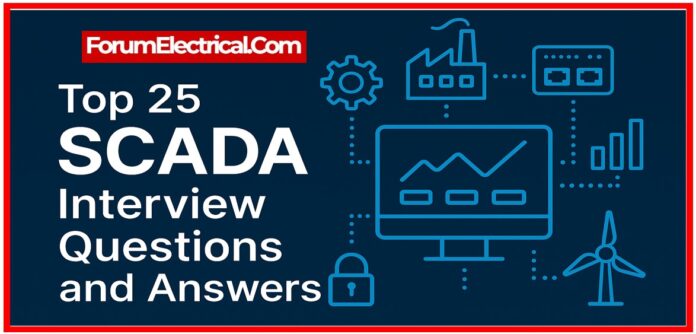1). What is SCADA?
SCADA – Supervisory Control and Data Acquisition
It is a system designed to monitor and control industrial operations such as power plants, substations & manufacturing.
2). What are the key components of a SCADA system?
- Remote Terminal Unit (RTU)
- Programmable Logic Controller (PLC)
- HMI (Human-Machine Interface
- Communication Infrastructure
- SCADA Server (Centralized Software)
3). What’s the difference between PLC and SCADA?
| PLC | SCADA |
| The PLC regulates hardware processes. | SCADA monitors & visualizes data from PLCs and RTUs. |
4). What is an RTU in SCADA?
RTUs are microprocessor-controlled electronic devices that connect physical objects to SCADA by providing telemetry data and accepting orders.
5). What is an HMI?
The Human Machine Interface (HMI) enables operators to see the process, monitor equipment, & interact with the system.
6). Which protocols are utilized in SCADA systems?
- Modbus
- DNP 3 (Distributed Network Protocol)
- OPC (OLE for Process Control).
- Profibus
- IEC 60870-5-101/104
7). What is Modbus?
A communication protocol for SCADA that allows numerous devices to connect over the same network.
8). What is the difference between Modbus RTU and Modbus TCP?
| Modbus RTU | Modbus TCP |
| RTU: Serial Communication (RS-232/RS-485). | TCP refers to Ethernet-based communication. |
9). What is the purpose of a SCADA gateway?
To maintain system compatibility, a gateway translates across many protocols or data types.
10). What does polling include in SCADA communication?
It is a method in which the master station requests data from slave devices at regular intervals.
11). Why is SCADA used?
For real-time monitoring, remote control, data logging, alarms, and improved operational efficiency.
12). What is a tag in SCADA?
A tag is a variable (data point) in SCADA that represents sensor/actuator values, alarms (or) statuses.
13). How is redundancy managed in SCADA?
High availability is achieved by the use of redundant servers, communication channels, and power supplies.
14). What are the trends in SCADA?
Historical & real-time trends graphically represent how variables change over time.
15). What is a SCADA alarm?
They alert the operator when process values exceed predefined limits.
16). How do you test a SCADA system?
By simulating inputs, testing alarm features, ensuring HMI responsiveness, and doing network tests.
17). What are the common SCADA troubleshooting steps?
Step-1: Check the communication wires.
Step-2: Validate sensor inputs.
Step-3: Check PLC/RTU status.
Step-4: Restart SCADA services.
Step-5: Review logs.
18). What are the potential cybersecurity threats in SCADA systems?
- Unauthorized Access
- Malware attacks.
- Data breaches.
- Denial of Service (DoS)
19). How does one secure a SCADA system?
- Use firewalls and VPNs.
- Disable unneeded ports.
- Patching and updates occur on a regular basis.
- Role-based access control.
20). What is a SCADA historian?
A database containing time-stamped historical process data for analysis & reporting.
21). What is the difference between Centralized & Distributed SCADA?
| Centralized SCADA | Distributed SCADA |
| All data processing takes place at one control center. | Processing is dispersed over numerous places for reliability. |
22). Can SCADA be used with renewable energy systems?
Yes, it is used to monitor and control solar, wind, and hydroelectric systems.
23). Explain a case in which SCADA failed and how you fixed it.
Real-World Example:
A communication failure with RTU owing to port difficulties, which was rectified by adjusting serial settings.
24). What is the delay in SCADA communication?
The time delay between data gathering and display is vital for real-time responses.
25). What are the trends in modern SCADA systems?
- Web-based HMI
- Cloud SCADA
- Integration with Industrial Internet of Things (IIoT)
- Mobile monitoring applications
- AI/ML-powered predictive analytics









